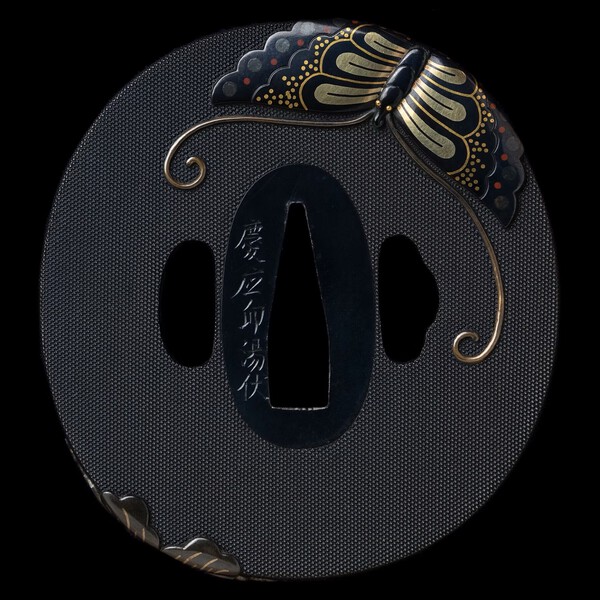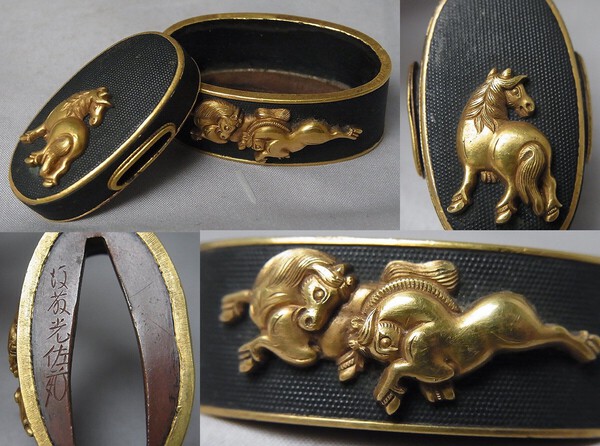-
Posts
102 -
Joined
-
Last visited
-
Days Won
2
Content Type
Profiles
Forums
Events
Store
Downloads
Gallery
Everything posted by Exclus1ve
-
Jack, Kirill, thank you for the comments! I think it's a gimei because the quality of the artwork could be better, and the signature is particularly crooked and unexpressive. Otherwise, it seems to be a popular theme among artists, and maybe someone has more examples?
-
Signed Sekijoken Taizan Motozane https://www.sothebys.com/en/buy/auction/2023/the-samurai-Japanese-arms-and-armour/a-tsuba-signed-sekijoken-taizan-motozane-and-kao
-
-
Hello! Recently, I had the opportunity to see and examine F/K works by the Mito school in person. The work is of medium quality, but I would still like to know the name of the artist. Additionally, someone could provide detailed information about the depicted scene.
-
Hello! I found a similar signature(mei) https://asahitoken.jp/contents/02_tosogu/details/tosogu-KZ/KZ084.html The author of Nao Kinao is Shoji Nara. According to the gold engineering book, Masatsugu is apparently a doujin with Masashiki, a disciple of Nara Masanaga, and is a metalworker in the mid-Edo period.
-
In this case, gilding is used. A gold emulsion is created, which is then heated until it turns red and hardens. This is a common method of gilding, as it uses less precious metal. Smaller elements are often inlaid. Large gold inserts are usually inlaid in exceptional-quality works. Sometimes, a thin gold plate is inlaid, and then the carving is applied to it. Often, you can distinguish the gilding from the pure insert by its color, as the patina on such parts, especially those that have been worn, is different and gives it away. I also recommend watching more Ford Hallam videos to gain a better understanding of the manufacturing processes for various Tosogu parts.
-
Hello! I've also done some research on my Soten tsuba set. I'm inclined to believe that your tsuba was made by a follower of Soten with their own unique style. There are noticeable differences in the way the pine tree is drawn, with its more elongated needles(with an Italian accent)) joke), which is not as common in the Soten school. Additionally, the tops of the waves have a concave point, whereas Soten often uses a round point, and the overall style of the waves is different. A similar plot, I suppose) The precise depictions of the clans are also not typical of Soten, and I really appreciate this detail on your tsuba! I also found a potential pair that is slightly smaller in size, both in appearance and in terms of the additional seki gane insert. Best regards Viktor
-
-
Excellent addition to the collection, Jake! It's time to start thinking about buying a camera))
-
Yes, that's right. It becomes perfectly clear when you see it in person. You can tell by the sharp, straight contour lines. Sometimes you can even see the incisor mark (about 50-100 microns thick) When a coating is applied, the contour becomes slightly blurred, and under magnification, you can see the difference in thickness.
-
Hi! Brian said it quite accurately. The mei can be in different places, sometimes even on a plate of pure gold inside. However, as with other tosogu items, it all comes down to the quality of the craftsmanship. The more intricate the work, the more likely it is that it was created by a renowned master who may have included a mei. In most cases, mei signatures are not present, which is normal. This item is genuine. Menuki are less likely to be counterfeited, and you can easily identify them.
-
-
I can't help but add the reference (in my opinion) quality of the nanako. I hope Marco doesn't mind if I post a photo of his Tsuba) Each point is perfect from any angle. https://www.tosogu.de
-
I believe that the Soten school or its followers are responsible for this. Most likely, the unusual shape of the cutouts is a result of the customer's request. The style and technique of the carving (the waves stand out particularly) are characteristic of Soten.
-
-
-
I'm inclined to assume that it's gimei. The mei is different, but I'm more confused by the workmanship.… The nanako is not done neatly, as is the inlay. However, it's still an interesting kozuka with a classic Goto school theme.
-
-
Video of one of the works:
-
Auction houses have always sold and will continue to sell fakes. Sometimes it's due to the incompetence of the auction house staff, but often they know exactly what they're doing — they just pretend otherwise.




















































